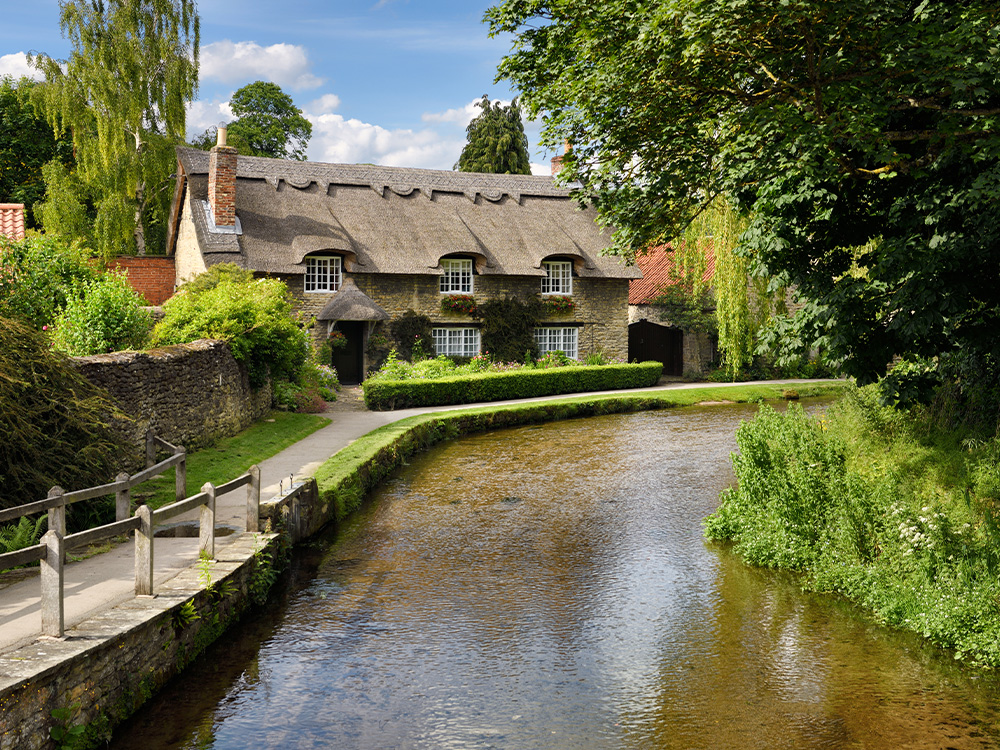Golden villages continue to lure property buyers
Despite increasing inflation and rising interest levels impacting property buyers in many areas of the UK, in sought-after locations properties are continuing to lure buyers and cause a property buying frenzy.

These sought-after locations are generally rural areas, where buyers are not just keen to buy, but willing to pay in excess of the guide price for the right home in the perfect location. Affectionately known as, ‘golden villages,’ these prime locations often have the traditional ‘chocolate box’ appeal of classic architectural style in an appealing rural village, as well as other key factors that buyers love.
For example, the most popular golden villages tend to have the best of everything, offering great lifestyle amenities, good connections to cities and other transport infrastructure, good schools and stunning countryside views. They’re villages that have a strong sense of identity and community spirit, plus tend to have popular pubs and thriving general stores still in existence.
Buyers of rural properties in desirable areas have been reported to be prepared to go well over the asking price in order to secure their perfect property. Bidding wars have become a common experience for the most sought-after properties, with buyers competing against each other to offer the highest bid.
What makes rural locations appealing?
Rural locations have always been popular with buyers, but interest in properties in the country recently became more noticeable during the pandemic when the desire for property with plenty of space, green views, and period homes with high-spec have increased. This is likely to be linked to the fact that more people were working from home, so no longer needed to be tied to urban areas – a trend that has continued, with more people continuing to work from home on a regular basis. Statistics from the ONS show that last year prices rose by three times the national rate in some rural areas, such as Conwy in North Wales, North Devon and Richmondshire in the Yorkshire Dales.
According to recent figures from Nationwide, the average price of properties has risen £26,000 in the last year, with the average price of a home in the UK now standing at £271,613. House prices in South West England have grown the most, followed by East Anglia – both parts of the country that boast appealing rural locations.
In most cases, though, the price tags in golden villages are way beyond the national average, which can seriously outprice the average local who longs to get on the property ladder in the area they’ve grown up in. Properties in these areas are not only priced higher, but with the bidding wars, rates are soaring higher.
News outlets have recently reported one Grade II listed house in Harting village in the Chichester District of West Sussex, had 40 viewings and two bids more than 20% over the asking price. Buyers are having to fight to secure the best country houses.
It’s not helped by the fact that it’s not just properties for sale that have been in demand, there’s also been an increased demand for rental properties in desirable rural areas, with prospective renters seeing properties snapped up as soon as they become available. It’s sadly no surprise that some people find themselves having to move to less expensive areas in order to get on both the rental and property ownership markets.
Prime London sales high too
It’s interesting to note that it’s not just property sales in golden rural areas that are still thriving. Recent figures from estate agent Savills show that sales of some of London’s most expensive properties in desirable prime city locations such as Chelsea, Kensington, Belgravia, Mayfair and Knightsbridge, hit their highest ever level this year.
There were 294 sales of properties worth £5m or more during the first half of 2022, with 89 homes selling for £10m or more. In fact, the sales for the first six months of 2022 have nearly matched the total of 308 £5m plus property sales made during the whole of 2019 – the last year that was completely unaffected by the pandemic.
Compared to the average house buyer, those looking for prime London properties are less likely to face issues with mortgage concerns and the cost of living, as their property budgets illustrate. Property experts also suggest that prime buyers may be turning to property instead of other investments, such as bonds or equities, as bricks and mortar may prove to be a better long-term investment in the current financial market.
As we move into a more uncertain financial outlook, with inflation and interest rates rising and the cost of living increasing, it will be interesting to see how the property market fares. There are likely to be issues ahead for the average UK buyer, especially anyone looking to secure a mortgage or get on the property ladder in late 2022 or 2023, but for those at the higher end of the market the situation may well be lessened.
In fact, this July saw London property prices fall by some 3.4%. However, with London rentals increasing near tube stations in the same month to an average of £2,222 per month (a 21% increase in the last year) and rental prices across London in general increasing by 15% to £1,832, it seems landlords will still see better revenues than ever before even if their capital investment reduces.
With an official recession looking likely in the near future, only time will tell if the property frenzy and bidding wars for prime golden properties will continue.
Residential Bridging Loan
A residential property bridging loan is fast, flexible bridging finance for property purchases. Buy-to-lets, HMOs, properties with short leases, property flips, investment purchases can all be financed, as can fixing chain breaks or mortgage delays, and refinancing an existing property loan. These loans require residential property or a group of properties as security.
Discover More




